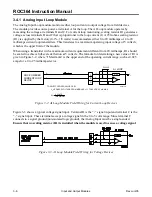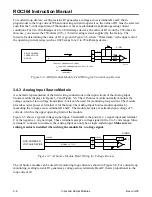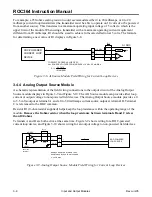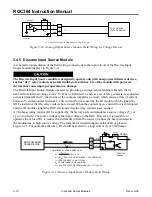
ROC364 Instruction Manual
3-20
Input and Output Modules
Rev Jun/05
RTDs with four wires normally have the compensation loop separate from the active element loop to
increase the accuracy of the probe. Various colors are used for the probe wires. For example, some
probes have wire colors of red and white for the RTD element loop and black leads for the compensation
loop, while other probes use two red leads for the active element loop and two white leads for the
compensation loop.
The connections in Figure 3-24 connect a 4-wire RTD with compensation loop to the 3-wire RTD
module. The RTD module designed for 3-wire use does not permit a 4-wire RTD to provide any
additional accuracy over a 3-wire RTD.
RED
4-WIRE RTD WITH
COMPEN-SATION
LOOP
WHT
WHT
RED
WHT
C
RED
WHT
B
A
RTD
I SRC
DOC4008A
Figure 3-24. RTD Input Module Field Wiring for Four-Wire RTD With Compensation Loop
Figure 3-25 shows the connections for a single-element, 4-wire RTD. The two leads for one side of the
RTD are both red, and for the other side, they are both white.
RED
4-WIRE RTD
WITH SINGLE
ELEMENT
WHT
WHT
RED
WHT
C
RED
WHT
B
A
RTD
I SRC
DOC4009A
Figure 3-25. Field Wiring for Four-Wire, Single Element RTD
3.4.16 HART Interface Module
The HART Interface module allows the ROC to interface with up to ten Highway Addressable Remote
Transducer (HART) devices per I/O slot. The HART module provides “loop source” power (+T) on
terminal A and two channels for communications on terminals B and C. The +T power is regulated by a
current limit. If the power required by all connected HART devices exceeds 40 milliamps (more than an
average of 4 milliamps each), the total number of HART devices must be reduced.
The HART module polls one channel at a time. If more than one device is connected to a channel in a
multi-drop configuration, the module polls all devices on that channel before it polls the second channel.
The HART protocol allows one second per poll for each device, so with five devices per channel the
entire poll time for the module would be ten seconds.
In a point-to-point configuration, only one HART device wires to each HART module channel. In a
multi-drop configuration, two to five HART devices can connect to a channel. In either case, terminal A
(+T) is wired in parallel to the positive (+) terminal on all of the HART devices, regardless of the
channel to which they are connected. Channel 1 (terminal B) is wired to the negative (–) terminal of a
single HART device, or in parallel to the negative terminals of two to five devices. Likewise, channel 2
(terminal C) is wired to the negative (–) terminal of a single HART device, or in parallel to the negative
terminals of a second group of two to five devices. Refer to Figure 3-26.
















































